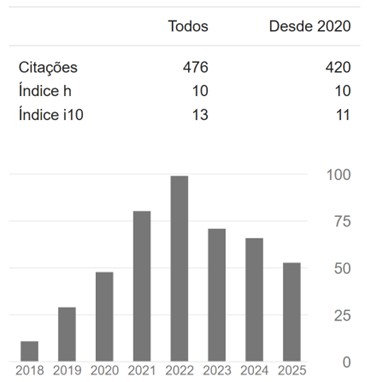Tratamento de efluentes de indústria alimentícia com o uso de hidrocalumita como adsorvente
Palavras-chave:
adsorção, corantes alimentícios, hidrocalumita, efluentesResumo
A remoção do colorido das águas naturais é um dos grandes problemas ambientais, uma vez que estes corantes são de difícil degradação devido a sua estrutura complexa e origem sintética. No entanto, com o aumento do rigor da legislação ambiental e devido às pressões da comunidade, tal problema precisa ser sanado, com o uso de tecnologias que sejam eficientes e economicamente viáveis. Neste estudo foi utilizado o adsorvente hidrocalumita (HDL‑CaAl-NO3), sintetizada pelo método de coprecipitação em pH variável, para adsorção de corantes sintéticos alimentícios, amarelo crepúsculo e azul brilhante. O HDL foi caracterizado por difração de raios X, espectroscopia no infravermelho, microscopia eletrônica de varredura, análise termogravimétrica, área superficial e volume de poros. Os resultados mostraram que para o corante azul brilhante, uma dosagem de 2° g/L de hidrocalumita já é suficiente para remover mais de 90% de sua coloração, atingindo 99% de eficiência com apenas 5° g/L. Todavia, para o amarelo crepúsculo essa mesma dosagem só remove 45% do corante, sendo necessária uma dosagem de 10° g/L para atingir 98% de eficiência. Observou-se também que a cinética de adsorção para os dois corantes ocorre de forma diferente, tendo em vista que a adsorção é mais rápida para o azul brilhante em relação ao amarelo crepúsculo.
Downloads
Referências
ABDOLMOHAMMAD-ZADEH, H.; KOHANSAL, S. Determination of mesalamine by spectrofluorometry in human serum after solid-phase extraction with Ni-Al layered double hydroxide as a nanosorbent. Journal of the Brazilian Chemical Society, v. 23, n. 3, p. 473–481, 2012.
ARAMI, M. et al. Equilibrium and kinetics studies for the adsorption of direct and acid dyes from aqueous solution by soy meal hull. Journal of Hazardous Materials, v. 135, n. 1–3, p. 171–179, 2006.
ARCO, M. del et al. Intercalation of mefenamic and meclofenamic acid anions in hydrotalcite like matrixes. Applied Clay Science, v. 36,
p. 133–140, 2007.
BHATTACHARYYA, K.G.; SARMA, A. Adsorption characteristics of the dye, brilliant green, on
neem leaf powder. Dyes and Pigments, v. 57, p. 211–222, 2003.
BERGAYA, F.; THENG, B.; LAGALY, G. Handbook of Clay Science: Developments in clay science,
vol. 1., 1. ed. Amsterdan: Elsevier, 2006.
BOUJAADY, H.E. et al. Removal of a textile dye by adsorption on synthetic calcium phosphates. Desalination, v. 275, p. 10–16, 2011.
CHOY, J.-H. et al. Nanohybrids of edible dyes intercalated in ZnAl layered double hydroxides.
Journal of Physics and Chemistry of Solids, v. 69, p. 1547–1551, 2008.
CRINI, G.; BADOT, P.-M. Application of chitosan, a natural aminopolysaccharide, for dye
removal from aqueous solutions by adsorption processes using batch studies: A review of recent literature. Progress in Polymer Science, v. 33, p. 399–447, 2008.
CUNHA, V.R.R.; FERREIRA, A.M. da C.; CONSTANTINO, V.R.L. Hidróxidos duplos lamelares:
Nanopartículas inorgânicas para armazenamento e liberação de espécies de interesse biológico e terapêutico. Química Nova, v. 33 (1), p. 159–171, 2010.
GHOREISHI, S.; HAGHIGHI, R. Chemical catalytic reaction and biological oxidation for treatment of non-biodegradable textile effluent. Chemical Engineering Journal, v. 95, p. 163–169, 2003.
GROVER, K.; KOMARNENI, S.; KATSUKI, H. Synthetic hydrotalcite-type and hydrocalumite-type
layered double hydroxides for arsenate uptake. Applied Clay Science, v. 48, p. 631–637, 2010.
HAQUE, E.; JUN, J.W.; JHUNG, S.H. Adsorptive removal of methyl orange and methylene blue
from aqueous solution with a metal-organic framework material, iron terephthalate (mof-
. Journal of Hazardous Materials, v. 185, p. 507–511, 2011.
KLOPROGGE, J.T. et al. Infrared and raman study of interlayer anions CO-23, NO-3, SO-24 and
ClO-4 in Mg/Al hydrotalcite. American Mineralogist, v. 87, p. 623–629, 2002.
KUNZ, A. et al. Novas tendências no tratamento de efluentes têxteis. Química Nova, v. 25 (1),
p. 78–82, 2002.
LATTERINI, L. et al. Organized chromophores in layered inorganic matrices. Inorganica Chimica Acta, v. 360, p. 728–740, 2007.
MARMITT, S.; PIROTTA, L.V.; STULP, S. Aplicação de fotólise direta e UV/H2O2 a efluente sintético contendo diferentes corantes alimentícios. Química Nova, v. 33(2), p. 384–388, 2010.
MUI, E.L. et al. Dye adsorption onto char from bamboo. Journal of Hazardous Materials, v. 177, p. 1001–1005, 2010.
OZER, D.; DURSUN, G.; OZER, A. Methylene blue adsorption from aqueous solution by dehydrated peanut hull. Journal of Hazardous Materials, v. 144, p. 171–179, 2007.
PAN, G. et al. Hydrogen production from aqueous-phase reforming of ethylene glycol over Ni/Sn/Al hydrotalcite derived catalysts. Applied Clay Science, v. 58, p. 108–113, 2012.
PONNUSAMI, V.; VIKRAM, S.; SRIVASTAVA, S. Guava (psidium guajava) leaf powder: Novel
adsorbent for removal of methylene blue from aqueous solutions. Journal of Hazardous Materials, v. 152, p. 276–286, 2008.
PURKAIT, M. et al. Removal of congo red using activated carbon and its regeneration. Journal of Hazardous Materials, v. 145, p. 287–295, 2007.
QIN, Q.; MA, J.; LIU, K. Adsorption of anionic dyes on ammonium-functionalized mcm-
Journal of Hazardous Materials, v. 162, p. 133–139, 2009.
RADHA, A.; KAMATH, P.V.; SHIVAKUMARA, C. Mechanism of the anion exchange reactions
of the layered double hydroxides (LDHs) of Ca and Mg with Al. Solid State Sciences, v. 7,
p. 1180–1187, 2005.
RAKI, L.; BEAUDOIN, J.; MITCHELL, L. Layered double hydroxide-like materials: Nanocomposites for use in concrete. Cement and Concrete Research, v. 34, p. 1717–1724, 2004.
ROJAS, R. et al. Edta modified LDHs as Cu2+ scavengers: Removal kinetics and sorbent stability. Journal of Colloid and Interface Science, v. 331, p. 425–431, 2009.
ROUQUEROL, F.; ROUQUEROL, J.; SING, K. Adsorption by Powders and Porous Solids. 1. ed. London: Academic Press, 1999. 468 p. SÁ, F.P. Adsorção e fotodegradação de corantes, amarelo crepúsculo e azul brilhante, para tratamento de efluentes de indústrias alimentícias. 2013. 109 f. Tese (Doutorado em Química) – Universidade Federal de Goiás, Goiânia, 2013.
SANGHI, R.; BHATTACHARYA, B. Review on decolorisation of aqueous dye solutions by low cost adsorbents. Coloration Technology, v. 118, p. 256– 269, 2002.
SANTOS, S.C.; BOAVENTURA, R.A. Adsorption modelling of textile dyes by sepiolite. Applied Clay Science, v. 42, p. 137–145, 2008. SERIO, M.D. et al. Mg/Al hydrotalcite catalyst for biodiesel production in continuous packed bed reactors. Catalysis Today, v. 195, p. 54–58, 2012.
SHEN, D. et al. Adsorption kinetics and isotherm of anionic dyes onto organo-bentonite from single and multisolute systems. Journal of Hazardous Materials, v. 172, p. 99–107, 2009.
TAN, I.; AHMAD, A.; HAMEED, B. Adsorption of basic dye on high-surface-area activated carbon prepared from coconut husk: Equilibrium, kinetic and thermodynamic studies. Journal of Hazardous Materials, v. 154, p. 337–346, 2008.
TAN, I.; AHMAD, A.; HAMEED, B. Preparation of activated carbon from coconut husk: Optimization study on removal of 2,4,6-trichlorophenol using response surface methodology. Journal of Hazardous Materials, v. 153, p. 709–717, 2008.
VIEILLE, L. et al. Hydrocalumite and its polymer derivatives. 2. polymer incorporation versus in situ polymerization of styrene-4-sulfonate. Chemistry of Materials, v. 15, p. 4369–4376, 2003.
WANG, S.; HUANG, J.; CHEN, F. Study on Mg-Al hydrotalcites in flame retardant paper preparation. BioResources, v. 7, p. 997–1007, 2012.
YANG, Q.Z.; YANG, J.; ZHANG, C.K. Synthesis and properties of cordycepin intercalates of Mg-Al-nitrate layered double hydroxides. International Journal of Pharmaceutics, v. 326, p. 148– 152, 2006.
YANG, Z.; FISCHER, H.; POLDER, R. Possibilities for improving corrosion protection of reinforced concrete by modified hydrotalcites – a literature review, In: ANDRADE, C.; GULIKERS, J. (Eds.). Advances in Modeling Concrete Service Life. Netherlands: Springer, v. 3, p. 95–105, 2012.
ZAHRIM, A.; TIZAOUI, C.; HILAL, n.Evaluation of several commercial synthetic polymers as flocculant aids for removal of highly concentrated C.I. acid black 210 dye. Journal of Hazardous Materials, v. 182, p. 624–630, 2010.
ZHANG, P.et al. Effective adsorption of sodium dodecylsulfate (SDS) by hydrocalumite (CaAl-LDH-Cl) induced by self-dissolution and re-precipitation mechanism. Journal of Colloid and Interface Science, v. 367, p. 264–271, 2012.
ZHANG, P.et al. Mechanism of interaction of hydrocalumites (Ca/Al-LDH) with methyl orange and acidic scarlet GR. Journal of Colloid and Interface Science, v. 365, p. 110–116, 2012.
ZHANG, P.et al. Near-infrared and mid-infrared investigations of Nadodecylbenzenesulfate intercalated into hydrocalumite chloride (CaAl-LDH-Cl). Spectrochimica Acta Part A, v. 79, p. 548–553, 2011.
ZHU, M.-X. et al. Sorption of an anionic dye by uncalcined and calcined layered double hydroxides: A case study. Journal of Hazardous Materials, v. 120, p. 163–171, 2005.
Downloads
Publicado
Versões
- 08.01.2024 (2)
- 30.06.2016 (1)
Métricas
Visualizações do artigo: 184 PDF downloads: 70
Como Citar
Edição
Seção
Licença
Copyright (c) 2016 Revista Tecnia

Este trabalho está licenciado sob uma licença Creative Commons Attribution 4.0 International License.
Autores e autoras que publicam na Tecnia concordam com os seguintes termos:
1) Autores e autoras mantêm os direitos autorais e concedem à revista o direito de primeira publicação, com o trabalho simultaneamente licenciado sob a Licença Creative Commons Attribution, que permite o compartilhamento do trabalho com reconhecimento da autoria e publicação inicial nesta revista.
2) Autores e autoras têm autorização para assumir contratos adicionais separadamente, para distribuição não exclusiva da versão do trabalho publicada nesta revista (ex.: publicar em repositório institucional ou como capítulo de livro), com reconhecimento de autoria e publicação inicial nesta revista.
3) Autores e autoras têm permissão e são estimulados a publicar e distribuir seu trabalho online (ex.: em repositórios institucionais ou na sua página pessoal) após a finalização do processo editorial, já que isso pode aumentar o impacto e a citação do trabalho publicado (Veja O Efeito do Acesso Livre).








